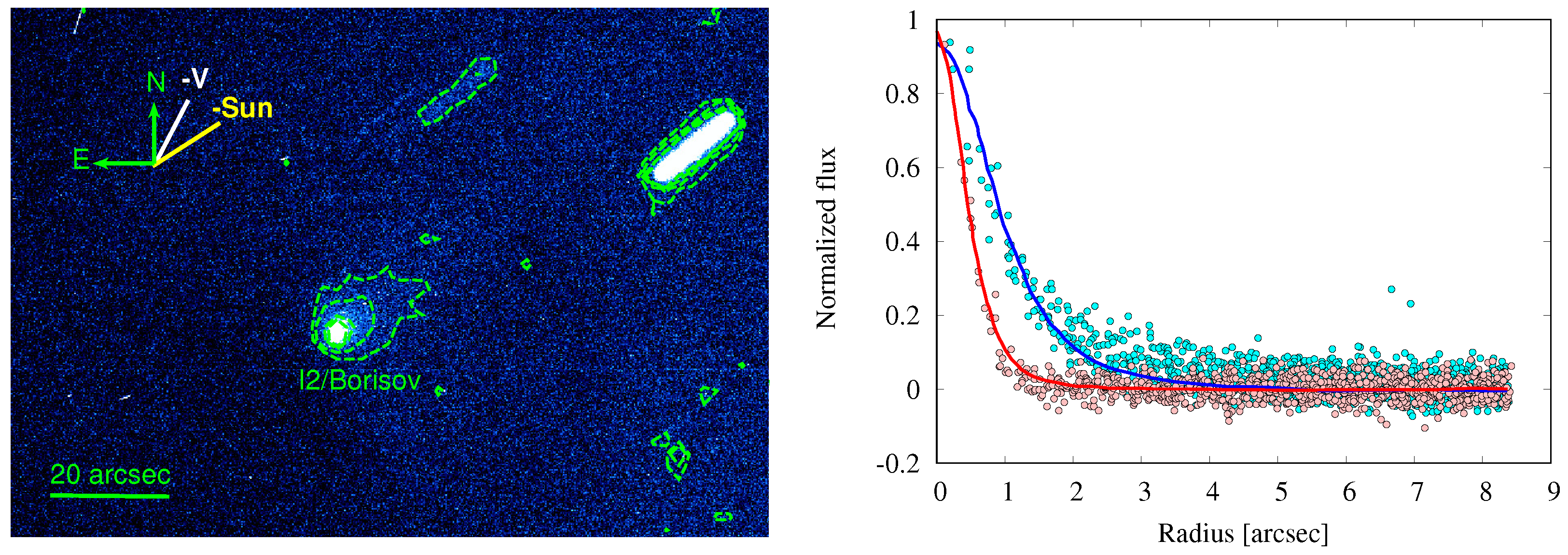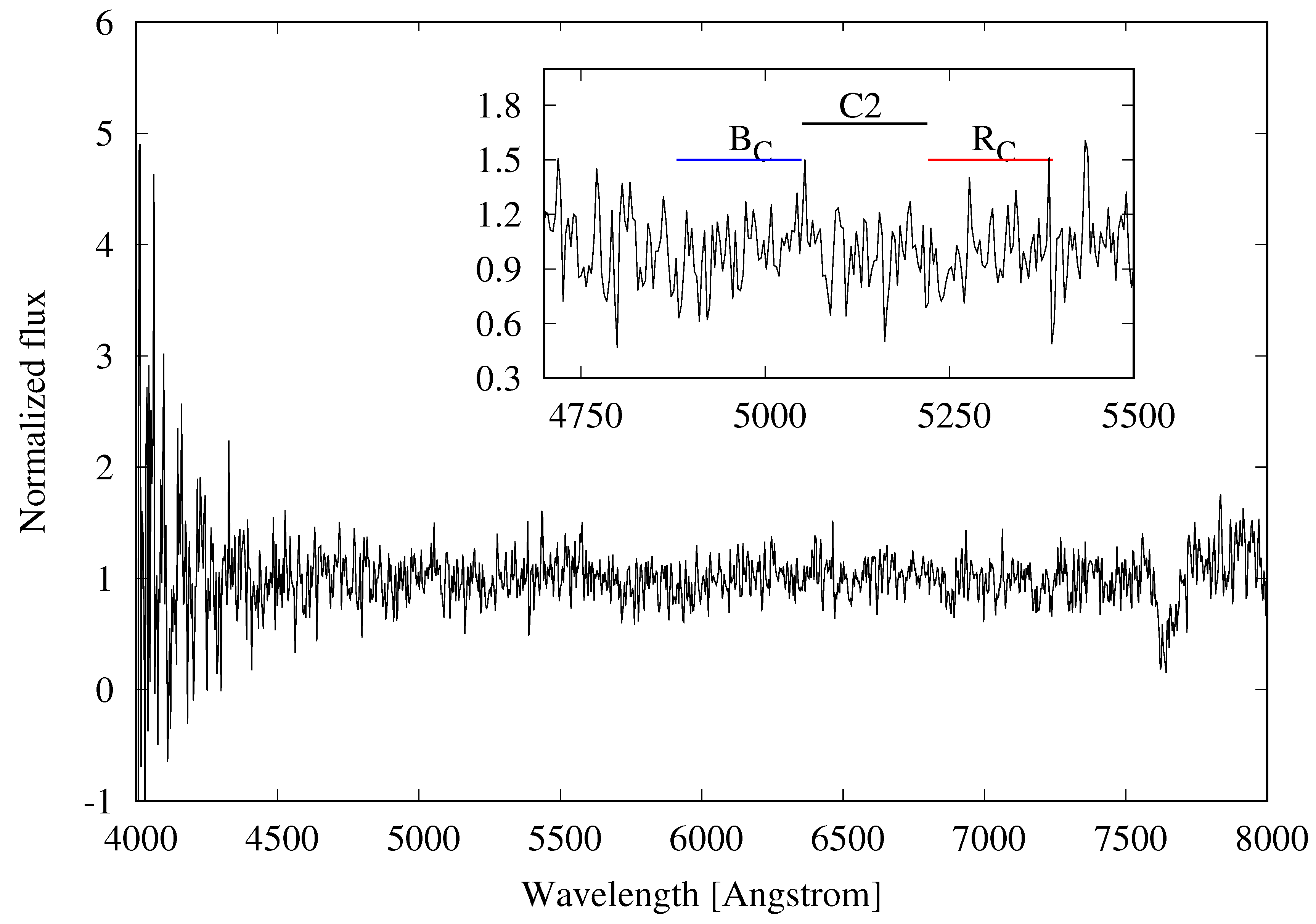Early Observations of the Interstellar Comet 2I/Borisov
Abstract
1. Introduction
2. Observation
3. Result and Discussion
Funding
Acknowledgments
Conflicts of Interest
References
- Guzik, P.; Drahus, M.; Rusek, K.; Waniak, W.; Cannizzaro, G.; Pastor-Marazuela, I. Initial characterization of interstellar comet 2I/Borisov. arXiv 2019, arXiv:1909.05851. [Google Scholar] [CrossRef]
- Meech, K.J.; Weryk, R.; Micheli, M.; Kleyna, J.T.; Hainaut, O.R.; Jedicke, R.; Wainscoat, R.J.; Chambers, K.C.; Keane, J.V.; Petric, A.; et al. A brief visit from a red and extremely elongated interstellar asteroid. Nature 2017, 552, 378. [Google Scholar] [CrossRef] [PubMed]
- Bertin, E.; Arnouts, S. SExtractor: Software for source extraction. Astron. Astrophys. Suppl. Ser. 1996, 117, 393. [Google Scholar] [CrossRef]
- Fernández, Y.R.; Kelley, M.S.; Lamy, P.L.; Toth, I.; Groussin, O.; Lisse, C.M.; A’Hearn, M.F.; Bauer, J.M.; Campins, H.; Fitzsimmons, A.; et al. Thermal properties, sizes, and size distribution of Jupiter-family cometary nuclei. Icarus 2013, 226, 1138. [Google Scholar] [CrossRef]
- Jorda, L.; Gaskell, R.; Capanna, C.; Hviid, S.; Lamy, P.; Ďurech, J.; Faury, G.; Groussin, O.; Gutiérrez, P.; Jackman, C.; et al. The global shape, density and rotation of Comet 67P/Churyumov-Gerasimenko from preperihelion Rosetta/OSIRIS observations. Icarus 2016, 277, 257. [Google Scholar] [CrossRef]
- Britt, D.T.; Consolmagno, G.J.; Merline, W.J. Small body density and porosity: New data, new insights. In Proceedings of the 37th Annual Lunar and Planetary Science Conference, The Woodlands, TX, USA, 21–25 March 2016. [Google Scholar]
- Fitzsimmons, A.; Hainaut, O.; Meech, K.J.; Jehin, E.; Moulane, Y.; Opitom, C.; Yang, B.; Keane, J.V.; Kleyna, J.T.; Micheli, M.; et al. Detection of CN gas in Interstellar Object 2I/Borisov. Astrophys. J. Lett. 2019, 885, L9. [Google Scholar] [CrossRef]
- Jewitt, D.; Luu, J. Initial Characterization of Interstellar Comet 2I/2019 Q4 (Borisov). arXiv 2019, arXiv:1910.02547. [Google Scholar] [CrossRef]
- Bolin, B.T.; Lisse, C.M.; Kasliwal, M.M.; Quimby, R.; Tan, H.; Ye, Q.; Copperwheat, C.; Fernandez, Y.R.; Lin, Z.Y.; Morbidelli, A.; et al. haracterization of the Nucleus, Morphology and Activity of Interstellar comet 2I/Borisov by Optical and Near-Infrared GROWTH, Apache Point, IRTF, ZTF, Keck and HST Observations. arXiv 2019, arXiv:1910.14004. [Google Scholar]
- De León, J.; Licandro, J.; Serra-Ricart, M.; Cabrera-Lavers, A.; Font Serra, J.; Scarpa, R.; de la Fuente Marcos, C.; de la Fuente Marcos, R. Interstellar Visitors: A Physical Characterization of Comet C/2019 Q4 (Borisov) with OSIRIS at the 10.4 m GTC. Res. Notes Am. Astrono. Soc. 2019, 3, 131. [Google Scholar] [CrossRef]
- Jewitt, D.; Kim, Y.; Luu, J.; Rajagopal, J.; Kotulla, R.; Ridgway, S.; Liu, W. Episodically Active Asteroid 6478 Gault. Astrophys. J. Lett. 2019, 876, L19. [Google Scholar] [CrossRef]
- Drilling, J.S.; Landolt, A.U. Allen’s Astrophysical Quantities; Springer: Berlin, Germany, 2000; Volume 381. [Google Scholar]
- Farnham, T.L.; Schleicher, D.G.; A’Hearn, M.F. The HB narrowband comet filters: Standard stars and calibrations. Icarus 2000, 147, 180. [Google Scholar] [CrossRef]
- Kareta, T.; Andrews, J.; Noonan, J.W.; Harris, W.M.; Smith, N.; O’Brien, P.; Sharkey, B.N.; Reddy, V.; Springmann, A.; Lejoly, C.; et al. Carbon Chain Depletion of 2I/Borisov. arXiv 2019, arXiv:1910.03222. [Google Scholar]
- Opitom, C.; Fitzsimmons, A.; Jehin, E.; Moulane, Y.; Hainaut, O.; Meech, K.J.; Yang, B.; Snodgrass, C.; Micheli, M.; Keane, J.V.; et al. 2I/Borisov: A C2-depleted interstellar comet. Astron. Astrophys. 2019, 631, L8. [Google Scholar] [CrossRef]
- Tsiganis, K.; Gomes, R.; Morbidelli, A.; Levison, H.F. Origin of the orbital architecture of the giant planets of the Solar System. Nature 2005, 435, 459. [Google Scholar] [CrossRef] [PubMed]
- Morbidelli, A.; Levison, H.F.; Tsiganis, K.; Gomes, R. Chaotic capture of Jupiter’s Trojan asteroids in the early Solar System. Nature 2005, 435, 462. [Google Scholar] [CrossRef] [PubMed]
- Gomes, R.; Levison, H.F.; Tsiganis, K.; Morbidelli, A. Origin of the cataclysmic Late Heavy Bombardment period of the terrestrial planets. Nature 2005, 435, 466. [Google Scholar] [CrossRef] [PubMed]


© 2019 by the author. Licensee MDPI, Basel, Switzerland. This article is an open access article distributed under the terms and conditions of the Creative Commons Attribution (CC BY) license (http://creativecommons.org/licenses/by/4.0/).
Share and Cite
Lee, C.-H. Early Observations of the Interstellar Comet 2I/Borisov. Geosciences 2019, 9, 519. https://doi.org/10.3390/geosciences9120519
Lee C-H. Early Observations of the Interstellar Comet 2I/Borisov. Geosciences. 2019; 9(12):519. https://doi.org/10.3390/geosciences9120519
Chicago/Turabian StyleLee, Chien-Hsiu. 2019. "Early Observations of the Interstellar Comet 2I/Borisov" Geosciences 9, no. 12: 519. https://doi.org/10.3390/geosciences9120519
APA StyleLee, C.-H. (2019). Early Observations of the Interstellar Comet 2I/Borisov. Geosciences, 9(12), 519. https://doi.org/10.3390/geosciences9120519




